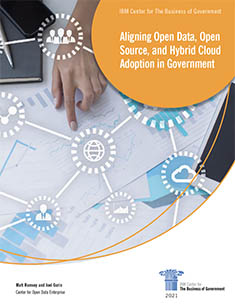
How Can Government Align “Open” Data and Technology Strategies to Improve Government Performance?

Guest Co-Blogger David Egts, Chief Technologist, North America Public Sector, Red Hat
Federal agencies are increasingly adopting cloud infrastructure, sharing their data across agencies and with the public, and relying on open source software as they seek to enhance their capabilities, improve efficiency through IT modernization, and leverage their data for policymaking and administration. These developments have been acknowledged and formalized via government- wide strategic initiatives including the Federal Cloud Computing Strategy, the Federal Data Strategy and implementation of the Evidence-Based Policymaking Act, and the Federal Source Code Policy.
To date, these domains have been addressed an implemented separately in agencies, with little focus on how they complement one another. Reviewing how best to implement them together will help make government information more transparent to the American public, promote efficiency in software development and interoperability across cloud domains, and increase the effectiveness and lower the costs of government operations.
A new report from the IBM Center for The Business of Government, Aligning Open Data, Open Source, and Hybrid Cloud Adoption Across Government, examines how these trends in analytics and technology intersect and can mutually reinforce one another. The report’s authors – Joel Gurin and Matt Rumsey from the Center for Open Data Enterprise -- draw on insights from an expert roundtable that brought together leaders in government use of data, software, and cloud approaches to discuss how these domains can they best be integrated. The report explores how government leaders and stakeholders can leverage the intersection of open data, open source, and hybrid cloud models to drive improved performance and productivity.
The report assesses government progress in each domain, and then importantly reviews how the domains align. Based on this analysis, the authors present a series of recommendations for how government can best leverage the synergies across cloud, open source and open data. These recommendations include high level considerations like improving workforce skills and sharing success stories, as well as specific proposals to update policy approaches in ways that promote an integrative data and technology strategy.
The analysis and recommendations from this report, drawing on the insights of senior leaders, can help government agencies and stakeholders in understanding and updating strategies that take advantage of the evolving capabilities presented by open data, open source software, and hybrid cloud implementation.



